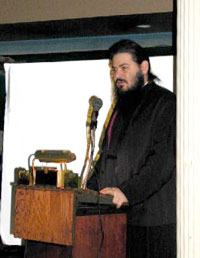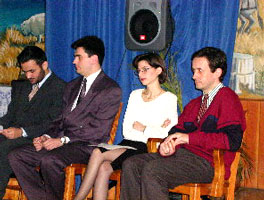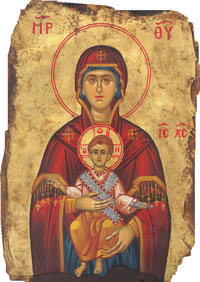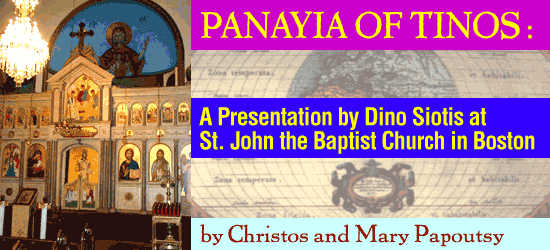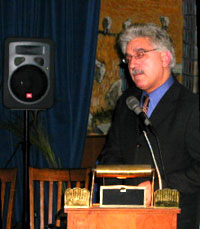|
|
|
|
On Saturday evening, March 31, 2001, the community of St. John the Baptist Church hosted an evening of Greek images, literature, music, iconography, and narration from the Greek island of Tinos. On our first visit to this church, we were delighted with the warm ambience of the people and setting for this program conducted entirely in Greek. The church itself set the tone for this warmth, with its traditional Byzantine imagery, and a magnificent icon of Panayia Platytera above the altar. The event, which was offered free of charge to the public, was attended by a capacity crowd in the lower level of St. John the Baptist.
|
|
|
|
Archimandritis Fr. Anastasios Tasopoulos, parish priest of St. John the Baptist, graciously welcomed members of the audience, sharing some of his impressions with them, and later introduced other presenters and speakers. First on the program were the featured cantors, Nektarios Antoniou and Menios Karanos, whose rich voices resonated throughout the lower level of the church between readings by Fr. Tasopoulos. The cantors chanted, in Byzantine Orthodox style, mostly ecclesiastical hymns to Panayia: "Plithis e ton Tinion," the Dismissal Hymn of the Discovery of the Miracle-working Icon of Panayia of Tinos, First Tone; "To Prostachthen Mystikos," kontakion of the Akathistos Hymnos, fourth plagal tone; "Panayia ke Laos," (Panayia and Populace) by Fotis Kontoglou; "Axion Esti," a Hymn to the Virgin Mary from the Divine Liturgy by unknown composer, and other similar selections.
|
|
|
|
Following the program of chanting, one specialist showed and discussed a slide collection of icons of the Virgin Mary. These masterpieces are located in many countries of the world, from Russia, Syria, Italy, and Tinos--all of them honoring Panayia in a diverse array of artistic styles. Byzantine music played in the background, nicely enhancing the visual effect of the slide presentation.
Dino Siotis, of the Greek Consulate of Boston, discussed the celebration of the feastdays of the Virgin Mary on his native island Tinos and showed some slides of these events. On August 15 every year, about 20,000 pilgrims visit the island for the largest and most spectacular of these feastdays. Their presence on the island has formed a stable economy for Tinos, funding many public works programs over the years. Mr. Siotis pointed out that there were many hundreds of churches and chapels on Tinos, nearly 400 of them dedicated to the Virgin Mary. With a deep and full voice, he read poignant lines of his own relevant poetry, in addition to the works of others.
|
|
|
The final portions of the program included a brief musical performance by chanter Nektarios Antoniou accompanied by a flutist and bass player from the New England Conservatory, and an epilogue by July Diamanti-Karanou.
|
|
|
|
|
| This full program of visual and auditory impressions of Panayia from Tinos was an excellent presentation, and very timely for Orthodox Christians during the final days of Great Lent. Especially effective was the use of simultaneous effects, combinations of sights and sounds, and readings accompanied by light background music. In the warmth of the church hall, members of the audience could easily transport themselves vicariously to the Holy sites of Tinos during the feastdays of Panayias. We, the authors, were enticed by the program, resolving to visit Tinos in the very near future. |
|
|
|
|
(Posting date 23 January 2003. Revision 15 August 2006.)
HCS encourages readers to view other articles and releases in our permanent, extensive archives at the URL http://www.helleniccomserve.com/contents.html.
|
|
|
|
2000 © Hellenic Communication Service, L.L.C. All Rights Reserved.
http://www.HellenicComServe.com
|


